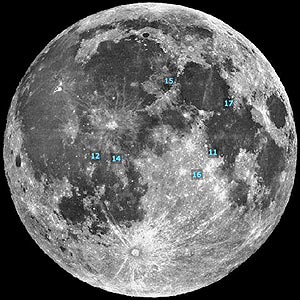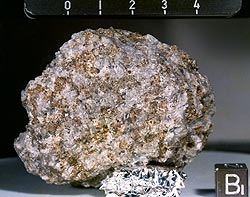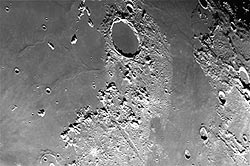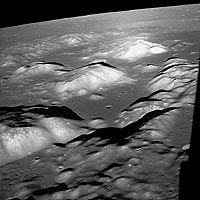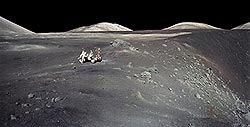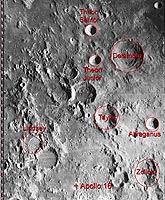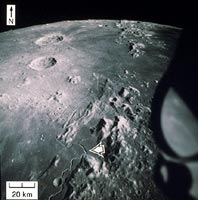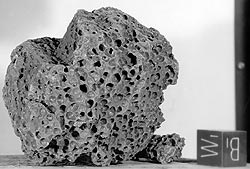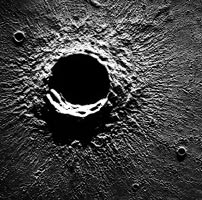|
|
|
To arrive at any reasonable estimate of the composition of even the lunar crust is difficult to impossible. To begin with we have randomly collected samples from compacted breccias from only six small areas and we have to recall that little progress was made on understanding the oceanic basalts until we had more than 10,000 analysed samples. The older light coloured high lying areas appear to be mainly formed of a very calcic anorthosite (or seem to be in two tiny areas) which it has been supposed, were a differentiate of the primary magmatic ocean formed when the moon first coalesced and melted in the heat of compaction of solid or semi solid fragments. At about 3byr bp there appears to have been a later resurgence of large meteor infall, which smashed up and remelted much of the older crust forming the dark Maria which can be seen by the naked eye. Large scale impact melting has not been observed on earth but as kinetic energy is converted in a few seconds to heat it should be possible, given the latent heat of fusion of basalt, to calculate how much basalt could be formed by an incoming thousand tons of chondrite, another good class exercise. We can speculate that the impact melts would not be total rock especially of a rock containing high T anorthite, and that at depth at least and perhaps marginally, lower temperature fractions might be formed. Detailed lunar map here. The Apollo Landings Unfortunately when seen through a telescope the image is inverted from that seen when using binoculars, so lunar images are often shown upside down and the view from the northern hemisphere is inverted when seen from the south. Let us assume an orientation as seen here where the circular Mare Crisium is to the top-right with Mare Serenitatus to its left followed by Tranqilitatus, the site of Apollo 11. The great mass of the Oceanus Procellarum then lies below and left of centre with Mare Imbrium overlapping somewhat above and left of centre and from the site of Apollo 15. Mare Nubium also overlaps near bottom with Humorum lower left above the rayed Tycho centre. A black band of Mare Figorus lies above left centre and apart from Mare Imbrium. Above the Apollo 12 and 14 sites is the Copernicus crater, also one of the younger impact craters though not rayed as prominently as Tycho. These are the main masses of flood basalt on the moon. Only very minor basalt areas occur on the far side, it seems meteorites were attracted by the larger mass of the Earth but missed and went on to crash into the Moon. One wonders how many hit the Earth in that period. The many younger craters are sometimes impacted on the basalt lava Maria. We see a range of structures in the smaller craters of 10 - 200 km size. Those less than about 50 km diameter, (NASA seldom provides a scale) are hemispherical in shape with little subsequent distortion. Those of about 100km diameter are deeper, show collapsed marginal wall scarps, and an uneven floor of back-fallen impactite. The larger craters of this type show rebound peak in the middle. Craters of ~200km diameter show collected pools of shock-melted basalt, sometimes with the central peak showing through, eg Eratosthenes, Tycho. Copernicus which is the conspicuous rayed crater at 20 deg lower left of centre in the Oceanus Procellerum has a raised central impact peak with some impact basalt. This is interesting because it is shockmelted basalt of the Oceanus Procellarum crust which is itself shock-melted but of unknown parentage. The crater Plato which lies near the Mare Imbrium a little above left centre of the moon is a flat pool of shock melted basalt and surrounded by the usual raised rim of ejected impactite. Only a handful of small younger impacts mar the surface, but due to the low resolution of NASA pix it is not possible to say how many. It appears to have the thinnest regolith covering known but we have no idea what this may be. Cores taken about 2m long in Apollo-15 showed over 50 varied layers from successive impact events and it is possible that near the boundaries of, say, Mare Imbrium, the regolith could be kilometres thick. There seems to be no positive record of massive basalt being uncovered in any of the Apollo landings, even the bases of minor craters 50 – 100ft deep seems to have exposed only old impactite.
Based on such a view as this we might plan a sample collecting expedition as follows. Firstly we would want to know what is the composition of the Alps, are they primary planetary surface, or anorthosites or impact breccias? Then what is the composition of the Oceanus Procellarum flood basalts, (and possibly those of the Figorus as well). Even if there is a moderately thick regolith cover, the floors of small carters should show the original surface. Then are the Plato impact basalts the same as those of the Oceanus? If so we can infer they were derived from the same rocks. Then we need to find a crater such as Copernicus to find whether an impact melt of an impact melt has the same or different compositions. Impact melts MAY be total melts or they may be lower T, high P fractionates. I do not think we have any ideas about this at present. And they would be quite difficult to form experimentally though not impossible. We would also want to know whether any regolith overlies the floor of Plato, Apollo 12 and 14 showed there was a great deal on Oceanus. It seem the most urgent tool needed on the moon is a decent backhoe. One day we my sink a drill hole a few thousand feet through the basaltic floor of Plato and we may learn a great deal, as it is, the high Ti rocks of Apollo-12 may simply be the result of the conditions of impact melt. Notice the dominant structural lineation leading from lower right to top left in the illustration above. The Apollo Landing Sites At one point in history, my very efficient secretary contacted NASA and suggested I should have a meeting with the Apollo astronauts to discuss what might be found, what to look for and how to get it. At that point we did not anticipate anorthosites but everything else is pretty much as expected except for the high Ti in some rocks and the very low soda. She was the most charming of persons but I happened hear her raised voice in the course of the conversation "But isn't that pretty stupid of you?" She had been told that no time had been allocated and there was no need! I still wonder if the later Astronauts could have landed on Oceanus and driven the moon buggy down onto Plato, (and got back!) Instead we see below where some of the Apollo missions landed. Apollo-15 This site lies in the hills immediately east of the Mare Imbrium lava lake. Again we see subdued hills blanketed by a heavy regolith cover, as we would expect being close to a major Mare. The site was chosen largey because of the proximity to the Hadley Rille, a winding rock crevasse, either a fault rent or it has been suggested, a collapsed lava tube. This Apollo-15 basaltic sample as displayed by NASA is given no description, but is strange in being vesicular, which implies the presense of gases or water vapour. Lunar rocks in general are unusual in their complete lack of alteration and zero water-gas content. Crushing such a sample should release gas. Apollo-14 This is the celebrated Fra Mauro Site, selected as being in the slightly hillier country compared to the very flat Maria located Apollo 11 and 12 sites. It appears to be a part of the thick regolith-surround of the Mare Imbrium impact. The terrain is undulating but not hilly or mountainous though optimistically termed "Highlands". The samples are low-Ti basalt probably unrelated to the underlying Oceanus Procellarum. Apollo-12 The Apollo-12 site is located on the Oceanus Procellarum south of Copernicus. As probably the oldest of the Maria, it is flat with a thick regolith blanket. The presense of metallic iron in the ferro-basalts may suggest impact of an iron meteorite. Apollo-11 The first Apollo landing was on the Mare Traquillitatus near the southwestern edge. High Titanium basalts are probably local. Only a short time was spent on the ground and the earlier landings did not carry a vehicle. The scenery is quite flat but with a thick regolith airfall blanket of unknown thickness. KREEP Some glassy regolithic material has quite high K, Rb, REE and P hence the name. When we look at tektites formed on earth they are always glasses of silicic or rhyolitic material, so impact melt may have a composition skewed towards the lower melting point fractions. Are KREEP the shock-melted products of shock-melted products of shock-melts? Photo Resolution Some records claim 1.8 million photos were taken during the Lunar Surveyor mission in the 1964 era and many more during Clementine in 1995. The astronauts used expensive Hassleblad cameras, yet the majority of pix taken both on the overflight missions and on the ground are not only bad they are appallingly bad. Pix taken of the Rover dune buggy are so bad that in a majority of cases it cannot be told whether the tires have tread, or whether the backs of seats are solid or have webbing. A number of reasons have been given for this :-
There are almost no close up pix taken of rocks or soils, and even some of the better ones are misidentified. Eg in fig 93 Michael Light shows some rocks with prominent white patches which he terms "basalt" from Apollo 17. It looks like a polymict breccia. What they really are is not certain at this point. The Chemistry of the Lunar Rocks. In general the rocks are basaltic with flat or negative slope REE and normalised patterns, and are all very depleted in volatiles and volatile elements. H2O and CO2 are completely lacking, and Na, K, Rb, are always very low, while REE are relatively high especially in the lunar "Soils" or glass droplets formed by impact melting. Many (if not all) of the samples collected are impactites and breccias, basalts and anorthosites which have been partially remelted by shock impact of meteorites.
The anorthosite-troctolites are rather similar to those from the isle of Rhum. One is inclined to speculate (as Dr Ross Taylor did) that a quiescent period allowed a largely molten planet to form an enormous closed layered intrusion or intrusions of which the roof was later broken and dispersed by meteorite impact, the low gravity, lack of air, and impact melting allowed the escape of the more volatile elements. However, a greater density of sampling might completely change this viewpoint. The high K, Rb, Si granophyric fractions may not have escaped lunar gravity, but simply not been sampled yet. Most lunar rocks, including the ferrobasalts (except a few in Apollo 15b) exhibit a negative europium anomaly. This seems to argue the presence somewhere of a sodic feldspar fraction as well as granophyric and peridotite rocks. On the other hand, shock melting may produce some chemical oddities we do not yet understand . One also has to ask, why did such a layered structure not form in the earth at the same time.
There appears to be a similarity between the fingerprint for the eucrites and the Lunar mare asalts. Howeve the eurcte data is very patchy, for example of almost 1000 partial analyses no one sample has been analysed for both K and Rb. Only a handfull have been done for both Rb and Nb, so we cnnot construct a reasonable finger print., but the same characteristics of very low Rb, K (and Na) with high Ba, Th, U appear to be present. A great deal more data is theoretically available but scattered widely through the literature over the last 30 y ears. No attempt has been made to put it into any database so much has been effectively lost. Many thanks are extended to NASA for providing free, the relevant Lunar Catalogues. The above interpretations I should add, are entirely my own. Copyright © Dr B.M.Gunn 1998-2006 |
||||||||||||||||||||||||||||||||||||||||||||||||||
The Moon
